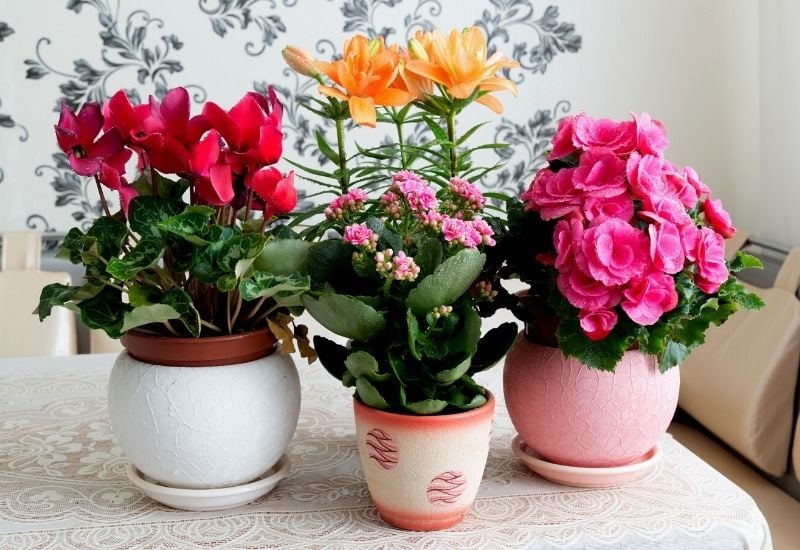
The same, green foliage plants quickly look boring and become more of an unloved dust catcher than a decorative eye-catcher.
However, the beauty of nature has bestowed us with a plethora of flowering houseplants that bedazzle our living spaces with their spectacular, vivid blooms. Certain varieties even perfume the air, imbuing your home with their signature fragrances.
Make your home a colorful oasis of well-being flow from late winter to fall without a laps by choosing a variety of indoor flowering plants with different bloom times, including African violet, flaming Katy, peace lily, Christmas cactus and more.
In fact a room can be a bit like a greenhouse, where you can host even flowering tropical varieties like orchids, flamingo flowers, even turmeric!
And no, most blooming houseplants are not hard to grow at all; they take to closed and protected spaces with steady conditions like houses and offices very well.
However, with the right amount of water, heat and choice of location, you can enjoy their beautiful blooms for as long as possible.
You don’t need a garden to enjoy wonderful flowers; you can grow flowering houseplants to bring the joy of spring at home!
We’ve done the legwork and picked the crème de la crème – the most vibrant, exotic, and fascinating flowering houseplants for your indoor paradise. And to top it off, we’ve got a handy guide on care tips to ensure they keep stealing the show, season after season!
18 Most Beautiful Flowering Houseplants That Are Easy To Grow Indoors
From low-light options to tropical to easy-care plants perfect for beginners! Here are 18 of our favorite flowering houseplants to add a bright pop of color, texture and even fragrance into your living room, bath, or bedroom.
1. Natan Lily (Clivia miniata)
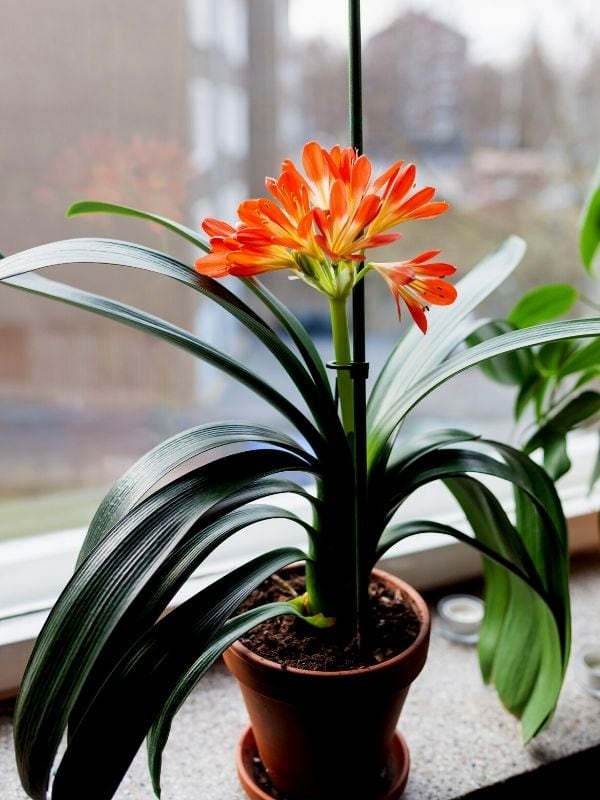
Native of South Africa and Swaziland, Natan lily is a classic indoor blooming perennial. Very sturdy, very reliable, it will come back in winter and spring with its clusters of exotic looking, funnel shaped bright orange flowers.
The long and tongue like leathery leaves are dark green, glossy and quite attractive on their own, just like a houseplant you keep for foliage. Easy to propagate and low maintenance,
you only need to keep it in a cool (not freezing) place for about 3 weeks in winter to encourage its early blossoms. It is a worthy winner of the Award of Garden Merit.
Natan lily is arguably one of the most popular flowering houseplant, and there is also a cram and yellow variety if you want to be original, Clivia miniata var. citrina. It does benefit from some fresh air outdoors during the warm months.
2. Flamingo Flower (Anthurium andreanum)
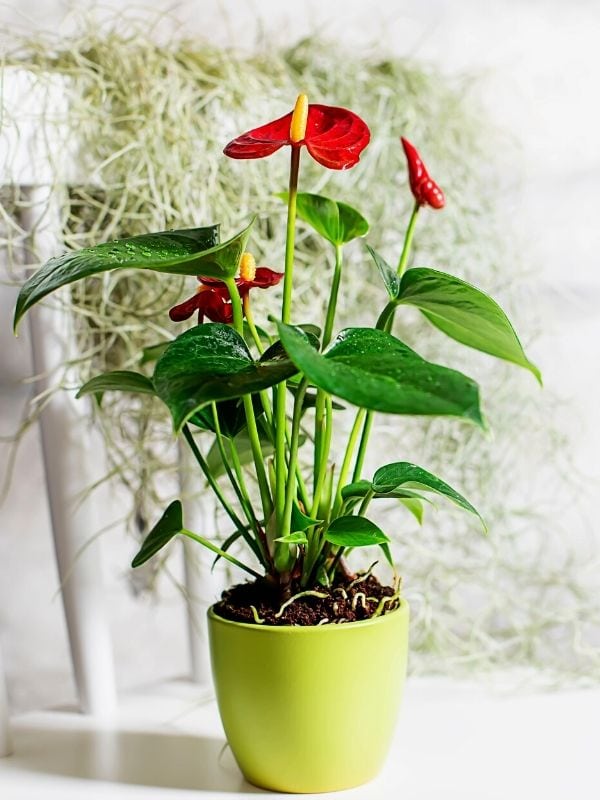
Flamingo flower takes its name from the famous colorful bird, and it comes to your home with its show stopping blooms.
With a saffron yellow spadix, what really catches your eye is the fiery red, incredibly bright, glossy and waxy spathe, that looks like a big, lacquered heart, up to 6 inches long (15 cm).
There are also white and pink varieties, as easy to find as the most common. You will have flowers at any time of the year, but the foliage is decorative too.
With large, dark green heart shaped leaves, up to 12 inches long (30 cm), smooth and exotic looking, it too will add to your indoor décor with a tropical forest look. No wonder it has won the Award of Garden Merit by the Royal Horticultural Society.
Despite its showy appearance, flamingo flower is low maintenance and fairly cheap as well; great value (and time saved) for money as well!
3. Christmas Cactus (Schlumbergera spp.)
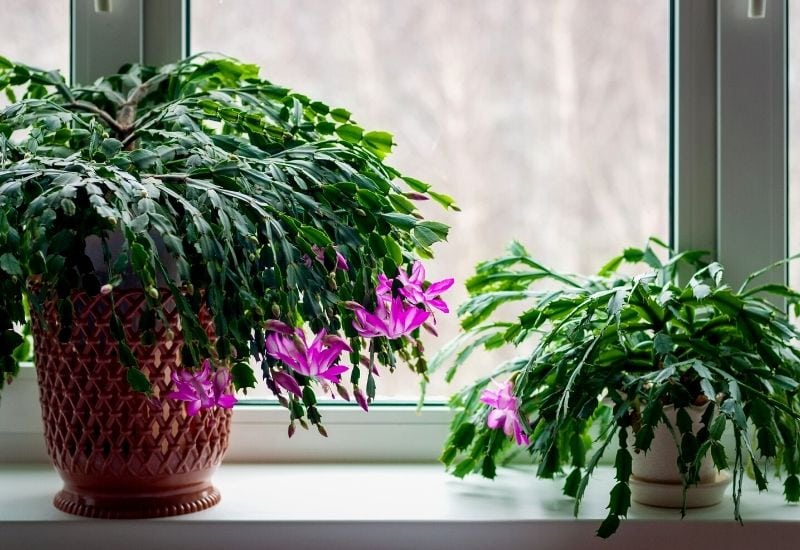
Brighten up you winter months with the amazing blooms of Christmas cactus, one of the most popular succulent houseplants ever!
The exotic looking flowers come at the tips of the stems when it is cold outside, and they can be red, orange, pink or white, and there are bicolor varieties too! Abundant and generous, the blossom will last for months!
The segmented stems too are very beautiful, smooth, mid green, glossy and arching, with a draping habit as well.
This perennial needs little care but it does not like to be moved around; once you have found it a suitable place, leave it there. They love bathrooms, by the way.
You can find Christmas cactus in virtually all garden centers in the world, and even in supermarkets when it is in bloom. While it is a succulent, drought will prevent it from blooming.
4. Star of Betlehem (Ornithogalum dubium)
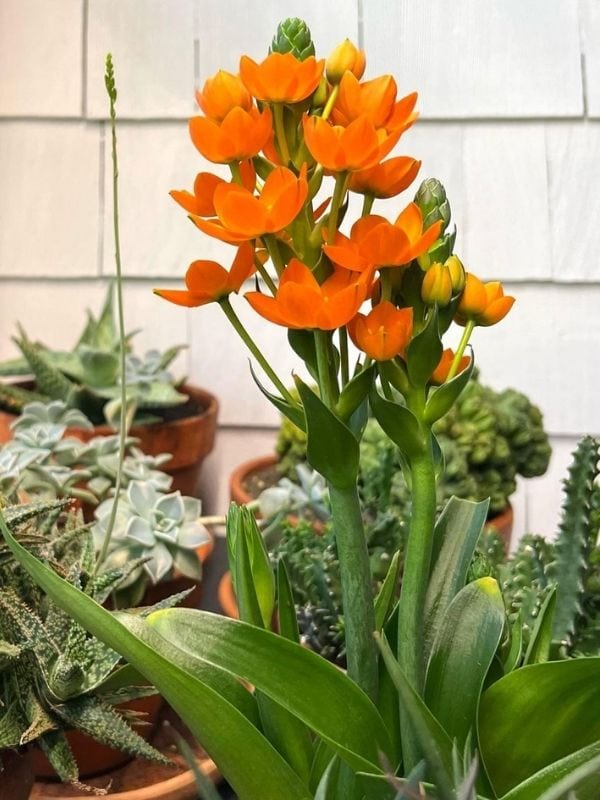
Award winning Star of Bethlehem will bring its South African energy to your home with a sunny smile!
This bulbous perennial has lovely bright orange flowers with six star shaped petals (tepals) in clusters of up to 25 opening on top of upright stems.
And you will have them for months in end! The fleshy, almost prostrate leaves are beneath them with their deep green, smooth presence.
They will die back later in the season, but don’t worry; they will come back again, after the bulb has had some rest in a cool and dry place.
Easy to grow, star of Betlehem is becoming more and more popular as a blooming houseplant; this has not gone under the radar of the Royal Horticultural Society, which has given it the Award of Garden Merit.
5. lady’s slipper orchid (Paphiopedilum concolor)
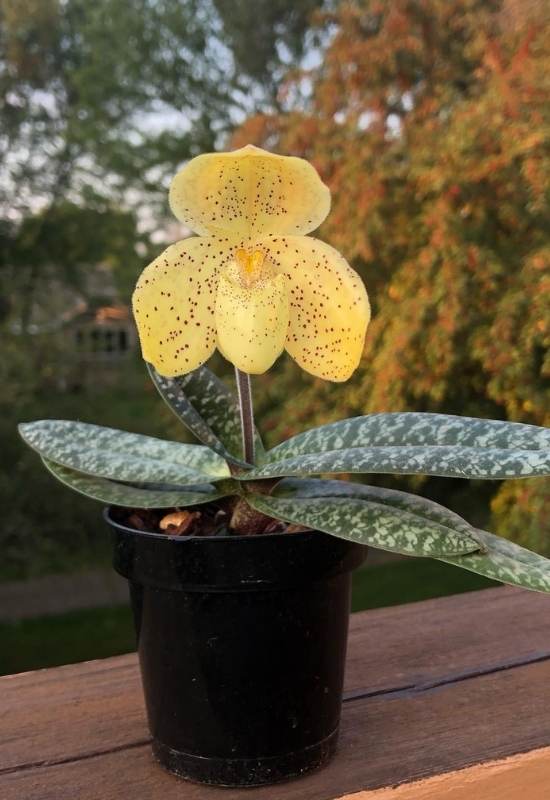
There are many slipper orchids that grow well as houseplant, but Venus has an especially sweet bloom.
These have broad and short petal, cream in color with lovely purple dots on them, forming triangle in shape.
The “slipper”, or labellum as we call it, is white and fairly small for this genus, and the flowers are also very fragrant and about 3 inches across (7.5 cm).
The broad, fleshy and glossy oval leaves are dark green many, small with silver patches on them. Small in size, it is also quite easy to grow.
Hailing from South East Asia, Venus slipper orchid is a refined and original variety that grows on steep and eroded limestone cliffs in its natural habitat.
6. Flaming Katy (Kalanchoe blossfeldiana)
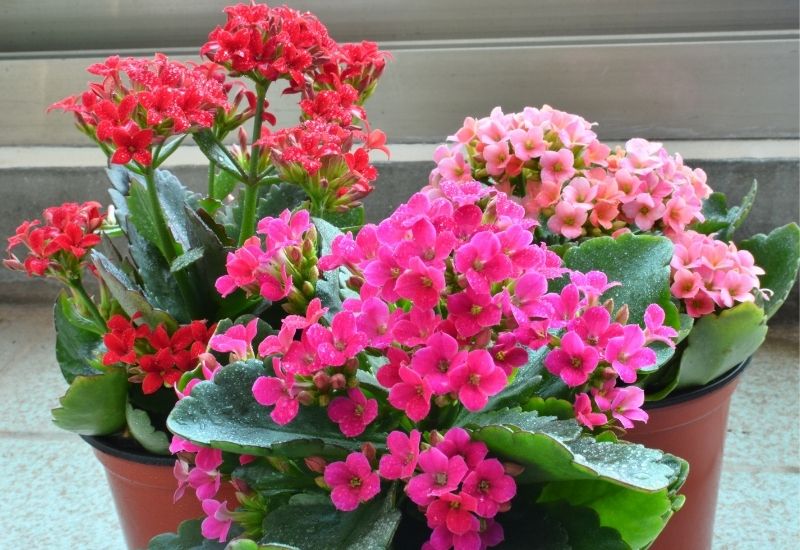
With lovely button like blooms, flaming Katy is a popular and easy to find houseplant. The flowers are small, but they come in great numbers above the foliage, with bright color in the warm range, red, orange, pink or yellow.
And they will last for about 6 weeks, sometimes even longer!
The leaves are succulent, broad and they form lovely clumps at the base of the plant with their rich and bright green color and scalloped edges.
Very cheap to buy, it has won the Award of Garden Merit by the Royal Horticultural Society.
Flaming Katy is equally popular as an indoor and outdoor flowering perennial, so you can take your pots outside to adorn your terrace in the summer months!
7. Amaryllis (Hippeastrum spp.)
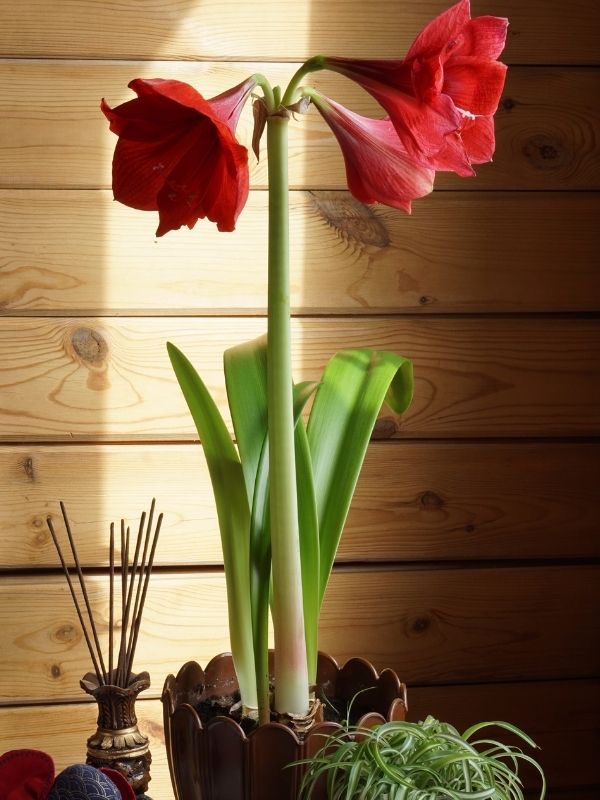
We could not forget the huge, jaw dropping blooms of amaryllis for an unforgettable indoor display.
This bulbous queen has some of the largest flowers you can have at home, reaching 10 inches across (25 cm).
These come quick after you plant the massive bulb, and you can have them in all colors from white to deep red. The most common variety is Hippeastrum x hortorum, but there are others as well.
The long, soft and tongue shaped leaves will keep you company a little longer than the flowers, then they will die back.
Cut the stem and foliage back as soon as they wither, then store the bulb in a cold and dry place. In late fall or early winter, place the bulb on top of a jar with water in it and then place it on a moderate heat source; when the new gem comes, you can plant it in a pot.
8. African Violet (Streptocarpus sect. Saintpaulia)
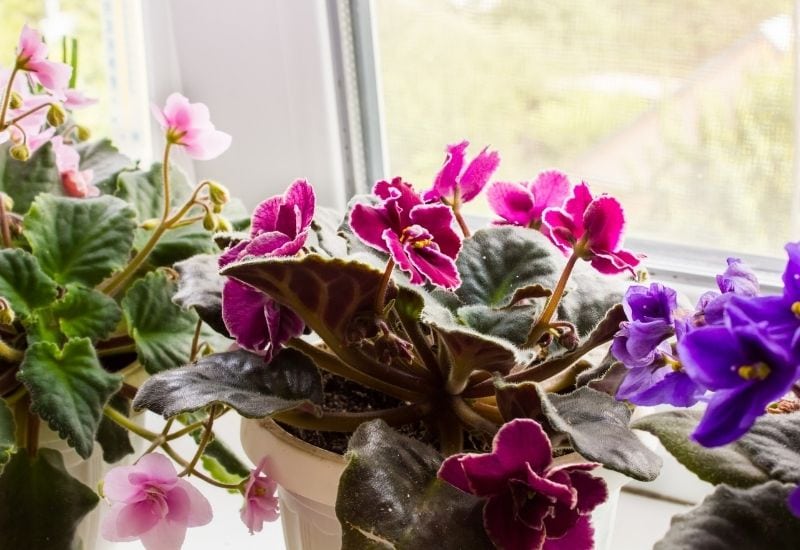
African violet is one of the sweetest blooming indoor plants ever, and one of the most loved.
While it is delicate, it also rewards you with its beautiful bright, round flowers that come in intense shades of purple, pink, blue, red or even white! And the tender looking fuzzy, broad prostrate leaves crown the blossom perfectly well.
Petite but enchanting, this little sweetheart can easily grace a small coffee table or even a bookshelf, but it needs some tender loving care.
Overwatering is often the cause of death of African violets, so, avoid it; in the end, remember that they carry the name of a very hot, but not particularly rainy continent, and they come from its east regions, in fact.
9. Queen of the Night (Epiphyllum oxypetalum)
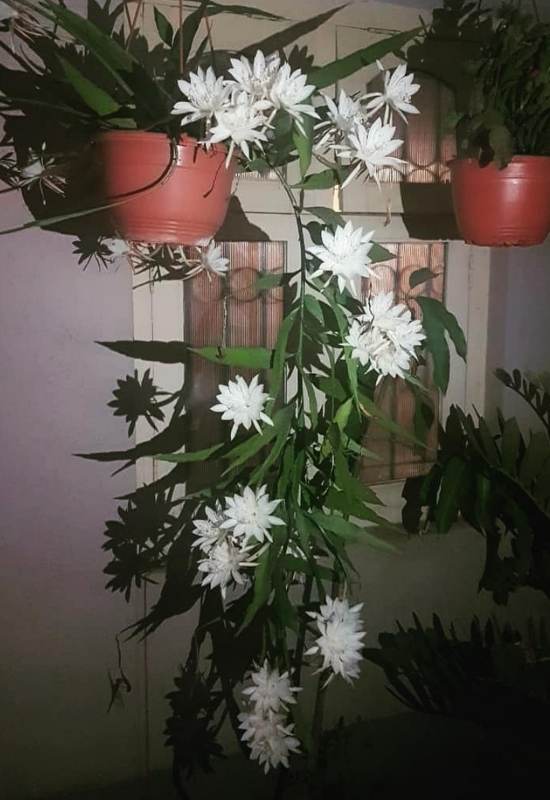
Queen of the night is also known as orchid cactus, and as soon as you see why, I am sure you will understand why it is a mind blowing houseplant!
To start with, its blooms are colossal: 12 inches long (30 cm) and 8 across (20 cm)! Then, they look exotic like few other flowers; long thin rays crown them, and the stiff, almost plastic looking waxy rows of snow white petals are just incredible.
Unfortunately, each will last only one night, but the spectacle is breathtaking nevertheless. This succulent also has long, flat and lobed green stems that make it beautiful all year round!.
Native of Mexico and Guatemala, queen of the night is a safe bloomer; despite its exotic loom and tropical appearance, the blossoms are guaranteed!
10. Persian Cyclamen (Cyclamen persicum)
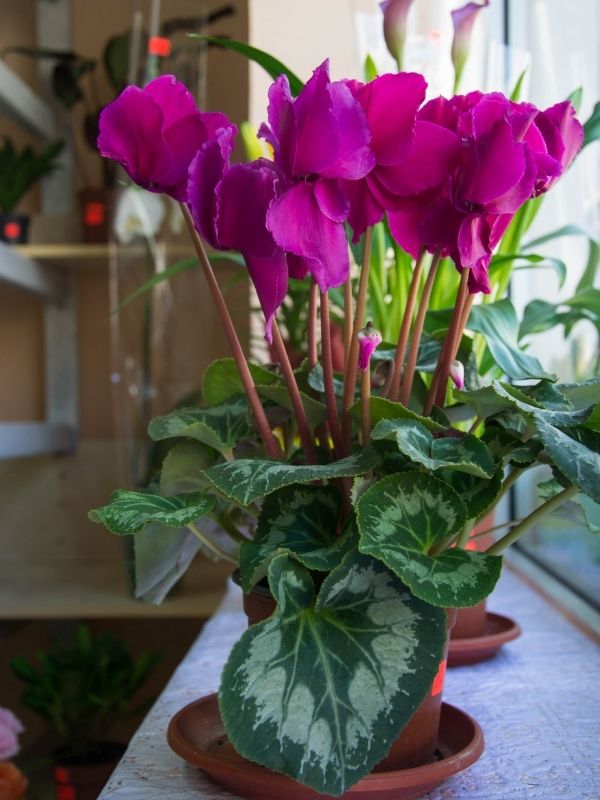
Far more delicate and less cold hardy than its garden relative Cyclamen coum, Persian violet is mainly grown as a beautiful blooming houseplant.
The reflex flowers typical of this genus will come on the thin stems, and in some common cultivars they can be quite large.
These come in shades of purple, pink, magenta, red and white, so you have a good choice, and some are fragrant as well. It is also a marathon bloomer, and it keeps coming for about three months.
The lovely heart shaped, fleshy leaves are prostrate, deep green with silver patterns on them.
Very popular as an indoor companion, Persian violet suffers if you overwater it; give it a bit of water from beneath regularly, and you will keep it happy.
11. Urn Plant (Aechmea fasciata)
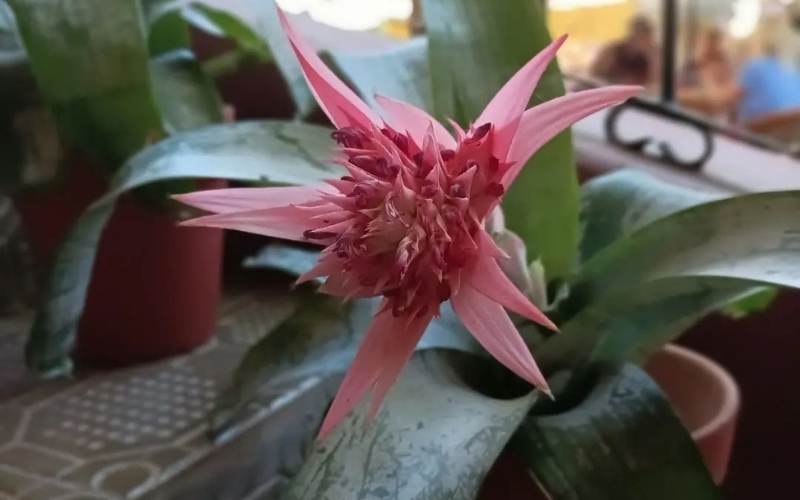
Urn plant is a bromeliad from Brazil that grows well indoors, and it has a trick up its sleeve. It will bloom, for many months, with small violet flowers.
Yes, the blooms are small but ten pink bracts that surround them are huge, forming an eye catching three dimensional star!
And they will last for a whopping 6 months! The leaves are long, pointed, curved outwards and hard, succulent and in a rosette.
Their color is green, but they are covered in a thin silver icing that makes them appear almost bluish.
It will take 3 years before the huge bract and bloom display appears in the middle of your urn plant, but the wait is really worthwhile. Or you can buy am adult specimen if you are in a hurry!
12. Peace Lily (Spathiphyllum spp.)
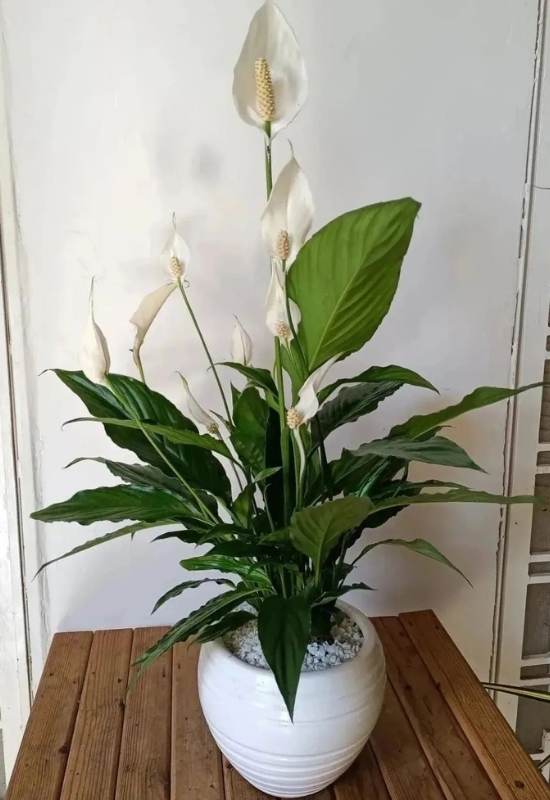
Peace lily is a popular flowering houseplant, also because it brings good energy according to Feng Shui.
Known for its elegant, upright pointed white spathes that enclose a cream colored spadix, these lovely perennial plants do indeed create a sense of calm and relaxation…
Easy to grow, and equally easy to propagate, this tropical blooming perennial also offers you graceful, large and broad pointed leaves in the deepest green shade, and quite glossy indeed.
Fairly adaptable, peace lily is also very cheap and easy to find in all garden centers, flower shops and even in generic supermarkets.
13. Moth Orchid (Phalaenopsis stuartiana)
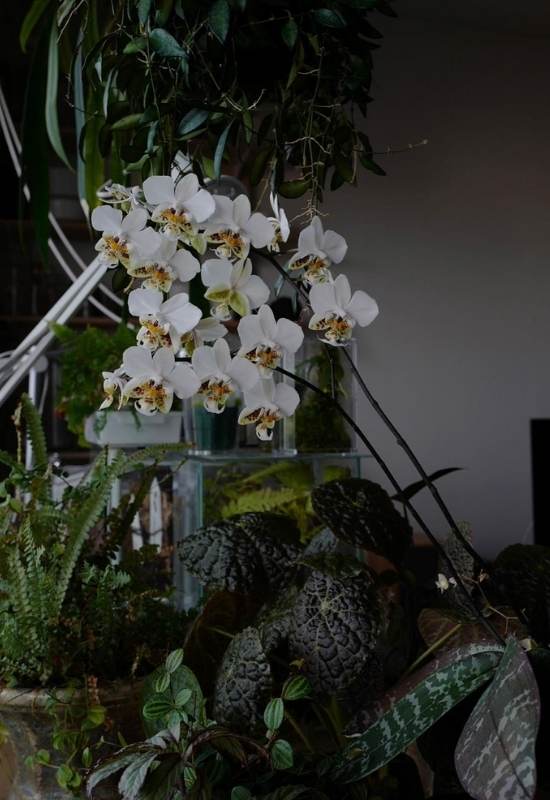
One of the great flowering queens of indoor places, offices and living rooms moth orchid could not miss from our list. The name comes from the fact that its petals look a bit like butterfly wings, and they have a waxy to sugary texture, very delicate indeed.
There are many varieties, but the one we picked must be the most iconic: snow white blooms with a small labellum and purple dots in the center that extol a light yellow blush.
Coming on long purple stems in groups of up to 100 (!!!), the blossoms are also scented! The broad, leathery but glossy leaves are oval and they curve elegantly downwards.
Moth orchid has an aura of peace on her, and with its long lasting blooms and gentle but very elegant presence, it can light up any indoor space, even the most difficult, like minimalist designs.
14. Gloxinia (Sinningia speciosa)
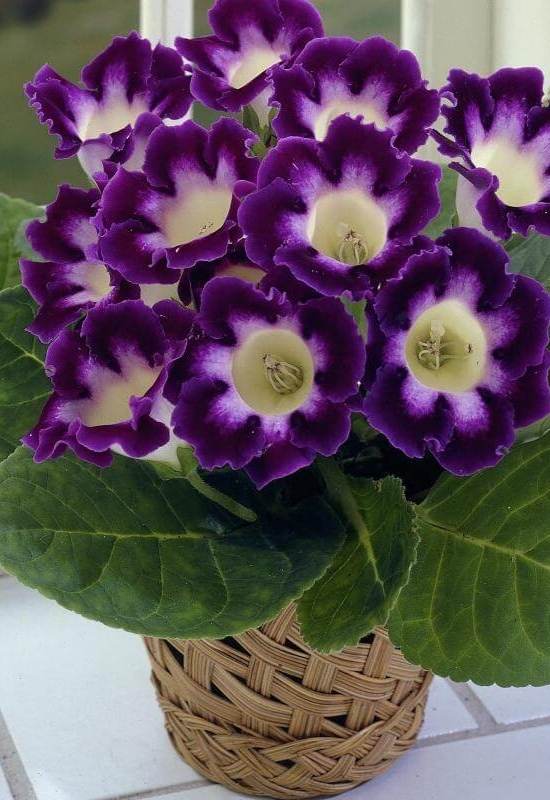
Gloxinia has the sweetest look ever, and it is perfect for a bright but countryside, or rustic looking indoor environment, but not just! Its super e colored blooms are world famous, and they look a bit like large primroses.
Coming in the most vibrant range of of white, yellow, orange, pink, blue and purple, often with edges of a different shades, they are just fantastic and despite their herbaceous look, perfect for homes and offices.
The broad, almost prostrate foliage just crowns the blooms with a cushion of fresh and shady rich green.
Gloxinias are very cheap and easy to get, low maintenance and often treated as annuals, but if you treat them well, they can give you joy for a few years with new blooms each time.
15. Giant Wax Flower (Hoya lauterbachii)
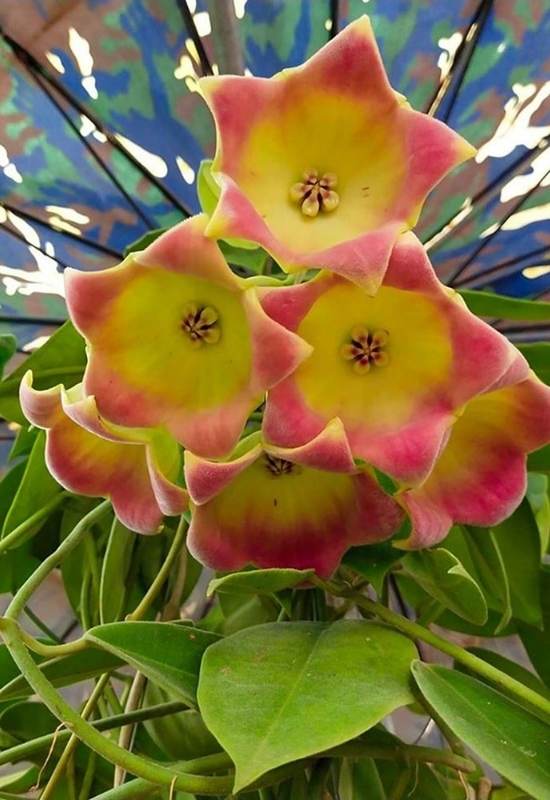
Waxplants are all very popular houseplants, but some have small blooms, not the variety we have chosen for you, giant wax flower, because its cup shaped, glossy flowers that look like they are made of beeswax are an unusual 3 inches across (8.0 cm)!
And they come in spherical clusters that can easily pass the foot in diameter (30 cm)… With joint petals, they form a bowl, but the tips remain detached, with a hint of the star shape of most blossoms of this large genus.
They come in a range of colors, from cream to yellow, orange, red, pink or purple, usually two in each head, one in the center and one on the outer parts. This is a vine, with beautiful, fleshy and deep opposite elliptical leaves.
If you are looking for showy blooms on a vine for an indoor space, giant wax flower is by far the best!
16. Zebra Plant (Aphelandra squarrosa)
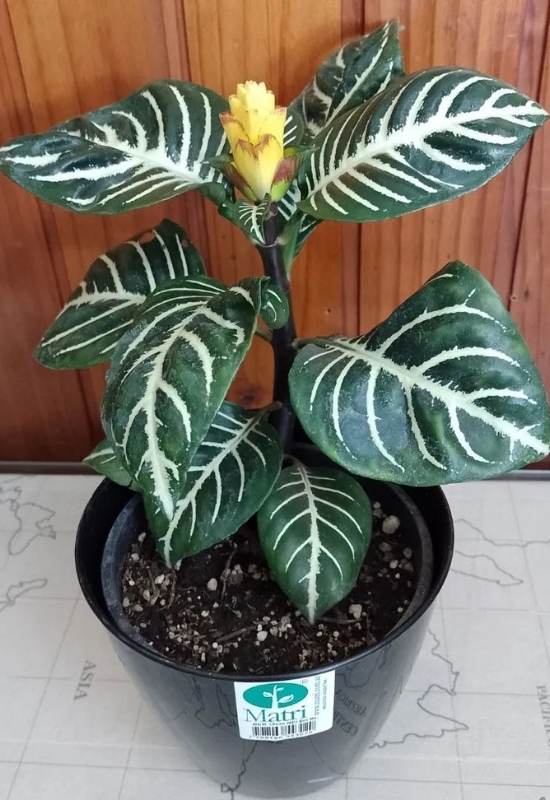
Coming from Brazil to your home, we all know zebra plant for its impressive foliage, but the blooms are no less eye catching.
Its large and broad, glossy and variegated leaves are green, often very dark, with white stripes, just like the animal it takes its name from. And the flowers are will add a touch of bright yellow at the t for a few months.
It’s hard to say what’s more exotic, because they come in bracts of the same color, often with dark red edges, in the shape of an open, pyramidal fir cone.
Zebra plant is a show stopping presence in any indoor space; place it where everybody can see it, in a focal position, and it will literally brighten up the whole room with its bold leaves and flowers!
17. Cape Primrose (Streptocarpus spp.)
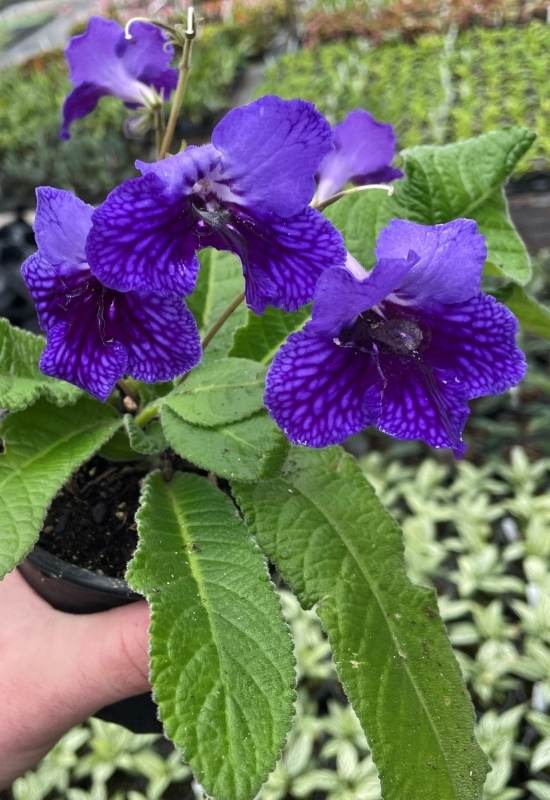
You can even have a full rainbow indoors if you grow different varieties of cape primrose! In fact, this evergreen perennial from South Africa has showy, funnel shaped blooms that can be white, lilac, blue, violet, pink, magenta, purple, even very dark and bright, as well as bicolor ones!
These come individually on long stems above the foliage, but you will get more than a dozen at a time! And did I mention that the blossoms can last for 10 consecutive months?
The leaves are herbaceous, ovate and long, arching slightly, bright green and with a rough, corrugated texture.
Easy to grow and very reliable, cape primrose is a very safe bet if you want to brighten up your house or office with a cheap flowering plant that gives you a lot. Very good value for money!
18. Turmeric (Curcuma longa)
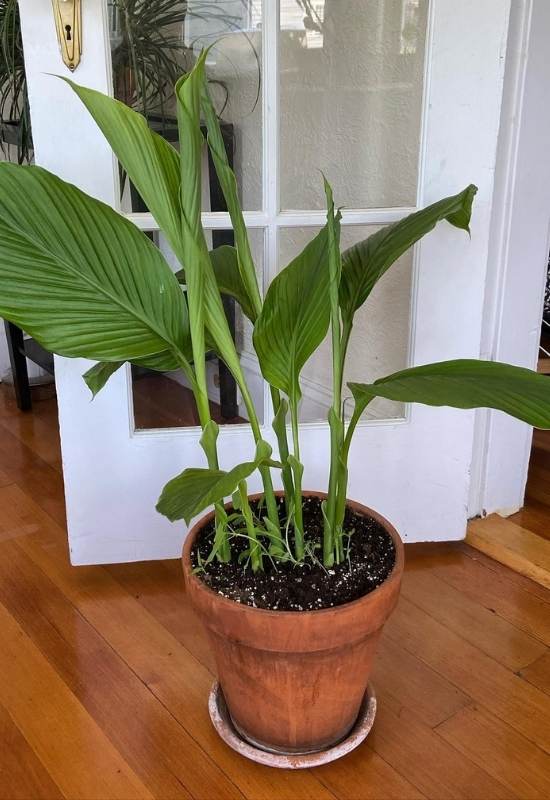
Yes, turmeric is not just a great spice, it is also a good houseplant with striking flowers! The leaves are glossy, mid green, pointed and erect, and this alone has great decorative value.
The stems that bear the flowers will rise just above them and… How to describe them… They look like pagodas, with rows of bracts that open in sequence and they can be white, yellow, green (even a strange almost fluorescent lime shade!), lilac, pink, magenta, red or purple.
Variegated varieties exist as well. While it is a newcomer in the world of indoor plants, it is becoming very popular indeed.
This rising star, turmeric, is finding its ways into garden centers, but you can even grow one from the tuber if you wish, and trust me, you will not regret it!
Lots of Great Flowers for Your Indoor Spaces!
So, these I believe are some of the best, most original, biggest, most colorful indoor flowers you can have.
There are others, but few match the orchids, succulents and other exotic beauties we have selected. Now it’s your time to take your pick!

Written By
Amber Noyes
Amber Noyes was born and raised in a suburban California town, San Mateo. She holds a master’s degree in horticulture from the University of California as well as a BS in Biology from the University of San Francisco. With experience working on an organic farm, water conservation research, farmers’ markets, and plant nursery, she understands what makes plants thrive and how we can better understand the connection between microclimate and plant health. When she’s not on the land, Amber loves informing people of new ideas/things related to gardening, especially organic gardening, houseplants, and growing plants in a small space.
